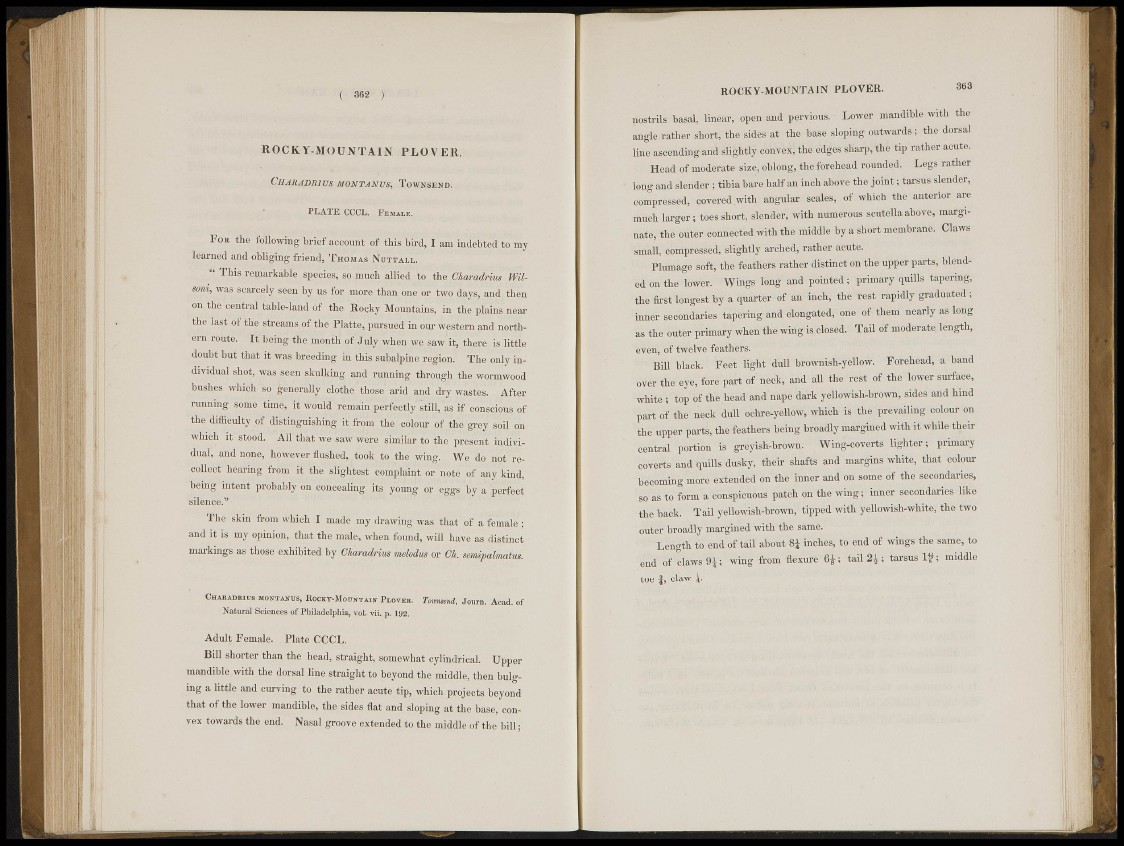
( 3 6 2 ' )
R O C K Y - M O U N T A I N PLOVER.
CHARABRim. MONTANUS, ToWNSi.NI!. ,
P L A T E COCL. ENNU.
" FOB. the following brief account of this bird, I aiu indebted to my
léarnet; and obliging friend, T H O M A S X I :TTAI . J ' *
" This remarkable species,' so much allied to^ thé Oharadrms Wilsoni,
was . ^ ^ ' ¿ p e n l'y us lor more than one or two days, awl thon
^ on, the "central table-land of the Ko,;kv .Mountains, in the plains near
the last of the stregWrf the Platte, pursued in our western and northera*
route. S i t being the month of'July when ^ saw'it, there is'little
doubt hut that it was breeding in this subalpine region. The only individual
Shot, was scon skulking and running through the wormwood
Implies which so fccm-rally clothe'those'arid and dry wasieft'' After
: rmi n i r i«' timê, it would remain perfectly ¿till. as if c.onacious of
the difficulty of distinguishing it from t teSgLi r of the grey soil on
Wh'iob 'if stiod. All that we saw were similar to W'presfint individual,
and none, however flushed!, took to the wing, We do not ro-
(tollom hearing from it the slightest complaint (.i;[noi|' of any kind,
being intent probably on concealing its young or eggs by a perfect
silenelf^ii'.
The- skin from which I made my drawing'was that ,of a female;
and it S my opinion, that the male, whggjfound, will h j l a s distinct
markings as those exhibited by 6/taradrws melodm or £®„ semipalmatns,
C H A E A D M U S MONTANUS, ROCKY-MOTOTAIII PLOVER. Tummnd, Journ. Acad, of
Natural Sciences of Philadelphia, vol- vii. p. 192.
Adult Female. I'late CCCL.
Bill shorter than the head, straight, somewhat cylindrical. Upper
mandible with the dorsal line straight to beyond the middle, then bulging
a little and curving to the rather acute tip, which projects beyond
that of the lower mandible, the sides flat and sloping at the base, convex
towards the end. Nasal groove extended to the. middle of the bill ;
R O C K Y - M O U N T A I N PLOVER. 363
nostrils basal, linear, open and pervious. • Lower mandible with the
angle rather short,-the sides at the bak sloping outwards ; the dorsal
line ascending and illghtly convex, the edges sharp, the tip rather acute.
Bead of moderate si/.p, oblong, the forehead rounded. Legs rather
long and slender ; tibia bare half an inch above the,¡joint; tarsus Slender,
compressed, covered,with angular scales, of which the anterior are
much larger; toes short, slomier, with numerous scutella above, marginate,
the outer connected with the middleAy a short membrane. Claws
small, compressed,'Sightly arehed, rather acute.
Plumage soft, the feathers rather distinct on the upper parts, blended
on the lower. Wings long and point®®? primary quills tapering,
the first longest by a quarter of at, inch, the rest rapidly graduated ;
inner secondaries tapering and elongated, one of them nearly as long
as the outer primary when the wing is.closed.' Tail of moderate, length,
even, of twelve feathers.
Bill black. Feet light dull brownish-yellow. Forehead, a band
tie eye, fore part of neck, and all » W of f l o w e r surface,
white ; tbp: of the head andinape dark yellowish-brown, side^ and hind
part of the neck dull ochrtvycllow, which is the prevailing colour on
t h e upper parts, the feathers being broadly margined with it while their
central portion Is greyish-browu. Wing-coverts lighter; primary
coverts and quills dusky, their shafts and margins white, that colour
becoming more extended on the inner and on some of the secondaries,
.80 ^ to form a conspicuous patch on the wing ; inner secondaries like
the batik. Tail yellowish-brown, tippet with yellowish-white, the two
outer broadly margined with the same.
Length to end of tail about Sj inches, to end of wings the same, to
end ei claws S i ; wing from flexure 6j; tail 2,j ; tarsus I f ; Middle
toe }, claw i